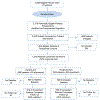Automated symptom and treatment side effect monitoring for improved quality of life among adults with diabetic peripheral neuropathy in primary care: a pragmatic, cluster, randomized, controlled trial
- PMID: 30343489
- PMCID: PMC7236318
- DOI: 10.1111/dme.13840
Automated symptom and treatment side effect monitoring for improved quality of life among adults with diabetic peripheral neuropathy in primary care: a pragmatic, cluster, randomized, controlled trial
Abstract
Aims: To evaluate the effectiveness of automated symptom and side effect monitoring on quality of life among individuals with symptomatic diabetic peripheral neuropathy.
Methods: We conducted a pragmatic, cluster randomized controlled trial (July 2014 to July 2016) within a large healthcare system. We randomized 1834 primary care physicians and prospectively recruited from their lists 1270 individuals with neuropathy who were newly prescribed medications for their symptoms. Intervention participants received automated telephone-based symptom and side effect monitoring with physician feedback over 6 months. The control group received usual care plus three non-interactive diabetes educational calls. Our primary outcomes were quality of life (EQ-5D) and select symptoms (e.g. pain) measured 4-8 weeks after starting medication and again 8 months after baseline. Process outcomes included receiving a clinically effective dose and communication between individuals with neuropathy and their primary care provider over 12 months. Interviewers collecting outcome data were blinded to intervention assignment.
Results: Some 1252 participants completed the baseline measures [mean age (sd): 67 (11.7), 53% female, 57% white, 8% Asian, 13% black, 20% Hispanic]. In total, 1179 participants (93%) completed follow-up (619 control, 560 intervention). Quality of life scores (intervention: 0.658 ± 0.094; control: 0.653 ± 0.092) and symptom severity were similar at baseline. The intervention had no effect on primary [EQ-5D: -0.002 (95% CI -0.01, 0.01), P = 0.623; pain: 0.295 (-0.75, 1.34), P = 0.579; sleep disruption: 0.342 (-0.18, 0.86), P = 0.196; lower extremity functioning: -0.079 (-1.27, 1.11), P = 0.896; depression: -0.462 (-1.24, 0.32); P = 0.247] or process outcomes.
Conclusions: Automated telephone monitoring and feedback alone were not effective at improving quality of life or symptoms for people with symptomatic diabetic peripheral neuropathy.
Trial registration: ClinicalTrials.gov (NCT02056431).
© 2018 Diabetes UK.
Conflict of interest statement
Conflicts of Interest Disclosures
The authors report no conflicts of interest and that the results of this paper have not been previously published. A brief abstract of the study findings is available on the PCORI webpage at
Figures


References
Publication types
MeSH terms
Associated data
Grants and funding
LinkOut - more resources
Full Text Sources
Medical

